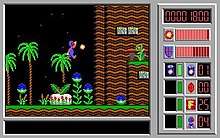Captain Comic II: Fractured Reality
Captain Comic II: Fractured Reality is the 1990 sequel to the 1988 MS-DOS platform game, The Adventures of Captain Comic. The game was created by the same author as the original, Michael Denio, working at Color Dreams and was published by ComputerEasy.
| Captain Comic II: Fractured Reality | |
|---|---|
 | |
| Developer(s) | Color Dreams |
| Publisher(s) | ComputerEasy |
| Designer(s) | Michael Denio |
| Platform(s) | MS-DOS |
| Release | 1990 |
| Genre(s) | Platform |
| Mode(s) | Single-player |
The game was not as successful as its predecessor, despite containing numerous improvements and new features:
- Save/continue-game feature
- Hundreds of objects to discover
- Multiple hidden rooms and bonus objects
- Four-way scrolling playfield with more color and graphics
- Many new tools for Comic to use
- Non-player characters to interact with
- A much more involved storyline
- The ability to swim, fly, ride a mine car and a sled
- The game is also reportedly three times the size of the original
Unlike the original (which was shareware), the game was sold commercially.
Gameplay
Captain Comic II is a platform game and like its predecessor has the concepts of shield points (health), lives, a score, items, enemies, zones and objectives.
The primary health indicator is the shield. Once the shield points are exhausted by coming into contact with enemy units and then he is struck again (or if he is hit for more damage than his remaining shields), Comic loses a life. Additionally, if Comic falls off the bottom of a screen a life is lost. If Comic finds a bonus shield it will restore the points to maximum, or add the shield to his inventory for later use if already at full. The game is over when Comic loses all of his lives (or completes the main objective of the game).
Bonus items can generally be found in strategic locations or inside boxes or crates that need to be opened up or destroyed by use of the pick-axe tool (one of the first goals of the game should therefore be to obtain the pick-axe). Items range from gems (points), shields (health), mini-Comics (bonus lives), to tools that can be used for other purposes. A notable addition is the magic wand which can turn some useless items into useful items, ranging from powerups to keys. Generally, items also add to the game score when collected. One new feature in this version of the game is the ability to change "active" it (perhaps a requirement since there are now many more items to collect and use). For example, the primary item in use is the firing weapon, but when it is time to use the pick-axe tool (or key, or screwdriver, etc.), Comic can select that item from his inventory.
Comic must also avoid or destroy various enemies in the game, primarily by use of his firepower which he obtains by collecting Blastola Cola (again, one of the first goals early in the game should be to acquire this item - of which there are 6 in total). Enemies range from simple units on pre-set paths to more difficult combatants that follow Comic or seek him out directly. Some enemies move faster than others, and most are restricted to their domain (fish enemies in water, for example). All enemies have the same general property in that when they come in contact with Comic they are destroyed, but reduce his shield points accordingly (from one to four shield points depending on the enemy, as opposed to two regardless of type in Captain Comic). Destroying enemy units by shooting them also increases the game score (100 to 400 points, depending on how many shield points would normally be deducted - note that some enemies cannot be destroyed by shooting them). Coming into contact with one of the temple masters also results in death.
The game is divided into major areas, each with smaller zones. Passing from one zone or area into another marks a safe point (although this version of the game also has a save-game feature). Typically areas are identified by the presence of doorways, which require the correct key (in the previous Episode one key opened all doors; in this Episode there are multiple keys denoted by color or design).
Comic can complete the main objective in the game, by successfully navigating areas and obtaining items (particularly tools) in what can be viewed as smaller objectives. For example, Comic must find the local leader to get the storyline, but also direction on obtaining the 'Temple Key' as a first objective. But there is also the side effect of learning where to acquire the pick-axe (from the guys working on the Escape Pods). As Comic works his way through the stages of the game, he collects more and better items to help with the increasingly difficult areas (particularly with regard to the enemies he must face).
Story
The game opens with this screen of text:
- EPISODE II: FRACTURED REALITY
- Returning from a victorious mission on the planet Tambi,
- Captain Comic set forth for the planet Omsoc, to return
- three priceless treasures plundered by Tambian thugs.
- Suddenly, Comic receives a weak distress call from an
- uncharted planet. A research base on the planet has been
- attacked by unknown forces and the science team needs
- help. Delaying his triumphant return to Omsoc, the Captain
- sets course for the troubled planet.
- On entering orbit, Comic sets his transporter to beam him
- near the base, and armed with only his courage, he enters
- the teleport chamber...
In the game, Comic must find a machine which allows him to travel to six different realities, in which he must collect the six crystals to save the planet and its inhabitants from evil aliens known as the "Skrejgib" (which, backwards, reads "Big Jerks").